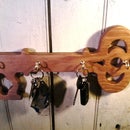Introduction: Nomadic Kitchen Nook Table
I had need for a table to fit into a unique corner of the kitchen, so I decided to make one from scratch, bearing in mind that I would also have to move it out of my current apartment five months from now.
So the main requirements were basically: be about 2'x3', be easy to install, and be easy to disassemble.
Now, to the ingredients! (What? Wood projects can have ingredients. Cooking instructables aren't the only ones allowed.)
Step 1: Assess the Situation
First, I measured the space where I planned to install the table. I approximated the dimensions to 2 feet wide by 3 feet long, seemed about right and small enough for a one-person kitchen nook.
After that, I cleaned up the area and went to organize myself:
Tools needed:
Table saw (or circular saw)
Jig saw (or coping saw)
Ruler and tape measure
Screw drivers
Drill press/drill bits
Level
Pencil
Materials needed:
Table legs (X2)
Table leg attachment brackets (X2)
3/4" thick 2'x4' plywood board (X1)
Scrap wood pieces - 23", 10" and 10" long
1.5" long wood screw or similar
Wood finish (stains or polyurethanes are both fine)
Step 2: Get Your Supplies and Set Up Shop
I went to Home Depot and bought everything on my list.
To save time later on, I stained the table legs first and set them aside to dry. Minwax Red Mahogany is a favorite stain of mine, so I used that.
Since I was low on table space (blame all my other projects), I set up a temporary work surface on my table saw. (Ahem, "table" is even in the name. It's legit!)
Step 3: Prepare the Mounting Frame Components
I made the mounting frame using IKEA 4"x0.75" bed slat pieces that I had laying around. The wall mounted piece measured 23" long, and the table top supports measured about 10" long. Again, to save time later on, I stained the three pieces at the same time as the table legs, prior to assembly.
When I got back to the project the next night, I marked where to assemble the support pieces to the wall mounted piece, estimating that three screws each should do well enough. (I wasn't planning on using glue, since I want this entire table to break down fully when I eventually uninstall it).
Next, I drilled a series of clearance holes for the screws that would attach this structure to the wall. Lastly, as a personal preference, I drilled counter-sinks for the screw heads with a 1/2" drill bit). (Technically this isn't necessary, since the bed slats are pine, meaning they would give to the pressure of the screw head anyway. But it's a good habit to implement in the long run.)
Lastly, I drilled the same hole pattern into the table top support ends, making sure the hole patterns lined up.
Step 4: Assemble the Mounting Frame
This is actually where a table saw comes in handy - for its precision level surface. Since I wanted this frame to evenly distribute support to the table top, I needed to make sure that the top surface of this frame was all at the same level.
I used 1.5" wood screws to assemble the three pieces to each other as shown in the photos, making sure that the frame came together as level as possible.
Finally, I inserted more wood screws into the wall mounting holes and set the frame aside.
Step 5: Get the Table Top Ready
In retrospect, what I did here is both oddly funny and hilarious baffling- clamping down the 2"x4" plywood to the table saw, then using a circular saw to cut through it. Wood makes you do strange things, I guess.
Aaaanyway, since my table design called for a 2'x3' surface, I set up my saw to cut 1' off the end of the 2'x4' piece.
Oh and I recommend saving the cut-off end for later - I always save nice leftovers like this 0.75"x1'x2'. It's birch ply, of course I'm gonna use it!
Step 6: Round Those Corners
No one likes to bump their thigh against a sharp table corner, so I wanted to round the two corners of the table that would be sticking out.
Here's a neat trick: need to draw a radius but don't have a stencil handy in your shop? What about a spray paint can? Yeah? Then use the cap! A standard spray paint cap is approximately 2.5" in diameter, and is handy as a circle stencil in a pinch.
I opted to use my coping saw for these radii, concerned that my jigsaw might muss up the plywood a bit too much. A coping saw takes a bit longer to cut through, but you have infinitely more control over the arc. Takes practice, but well worth it. After rough sawing the curves, I used a file to smooth them out, then sandpaper (120, then 220, then 320) to finish them off.
And then I went ahead and sanded down the entire table top - edges and surfaces, in the same sandpaper grit order as with the corners till everything felt silky-smooth.
Remember - if you're using a table every day, the last thing you want is a splinter when you walk by. Sand it down good, then sand it down again just to be sure!
Step 7: Mount the Leg Brackets
Now for the mounting brackets. There are plenty of ways to attach legs to a table, but like I said before, I chose to use these specifically so that this table can disassemble cleanly and efficiently.
Positioning them where I felt best on the underside of the table, I marked all the screw holes and the nut hole. I pre-drilled the holes with a 1/16" drill bit, then with the appropriate bit for the screws (in this case, a 7/64" bit). I also drilled out the hole below the nut with a 1/2" Forstner bit, 1/2" deep, to make sure there would be clearance for the table leg screw that goes in there.
After that, it's just screwing down both brackets with my handheld Rigid drill gun.
Now for the test fit!
Step 8: Test Fit the Table in Place
Before going any further, I wanted to make sure everything fit as intended, so I brought all of the parts up to the kitchen. I screwed the legs to the table lickity-split, and stood it upright. Using my level and holding the table up with my hands, I got the surface nice and level and marked on the wall where to attach the Mounting Frame.
I was lucky that the wall I'd be attaching to was wooden, so I screwed the Frame directly to the wall with 1.5" wood screws. Pro-tip: after attaching and tightening the first screw, I used my level to recheck the frame's alignment before screwing in the rest.
With the Mounting Frame secure, I put the table back in place, rechecked the level (using a weight to hold down the back end flush to the Frame), pulled a chair up to make sure the table legs wouldn't interfere with it.
Finding no problems, I was good to go!
Step 9: Create the Mounting Holes
The last features for table are the mounting holes that will attach the table top to the Mounting Frame.
The hole pattern isn't critical, as long as it matches up somehow to the Frame, which I ensured it would.
In the case of these holes, counter-bores are rather critical, to ensure that the screw head doesn't stick up above the table surface even a little bit. I used a 1/2" Forstner bit to make sure there would be clearance all around the screw head.
Step 10: Stain the Table Top
Finally staining the table top (after removing the leg mounting brackets, of course)! I used Minwax Red Mahogany, I love how birch grain patterns pop out.
Pro-tip: don't use brushes when staining wood, since the brushes may leave brush marks/lines. Use old socks! Cloth in general works way better for spreading out stain without leaving streak marks.
Now, because I was impatient and needed a kitchen table ASAP, I didn't take the time to polyurethane the surface.
SHAAAAAAAAAAAAME.
I know, I know. I'll get to it eventually. Or during the next move. Oh well.
Onwards to final installation!
Step 11: Install the Table (for Real This Time!)
After the table top dried off, I reattached the table leg mounting brackets, and then the legs.
I drilled screw holes into the Mounting Frame that matched up the screw clearance holes in the table top for attachment.
Positioning the table in place and looking to make sure everything was aligned, I screwed the table to the frame with my drill gun (lookit that extension bit though!).
Aaaaaaaaaand that's the way it goes!
Step 12: All Done!
And there it is. Looking under the table, I saw that the Mounting Frame is completely flush with the under-table surface, which is great.
And let me tell you, those three wood screws attaching the table top to the Frame go a looooong way, this thing isn't budging no matter how clumsily I'll run into it.
In retrospect, there were many things I could have done differently or improved upon with this design. But in the end I wanted something simple, and I gave myself three nights to get it done, which I did. So no regrets here.
Anyway, thanks for reading! Hope you learned something new from this, and if you're feelin friendly, vote for me in the Woodworking Contest!
Cheers, ya'll.
-Eugene

Participated in the
Woodworking Contest 2017













